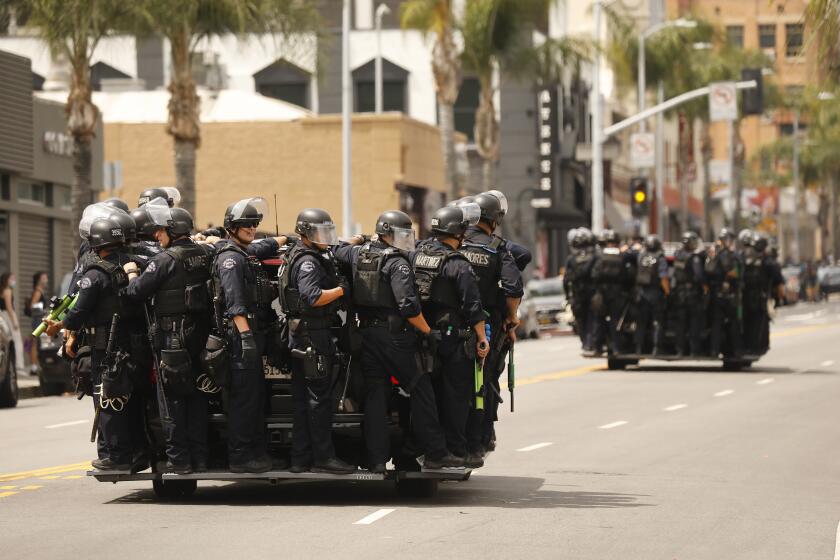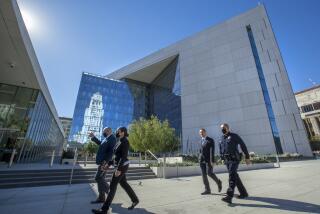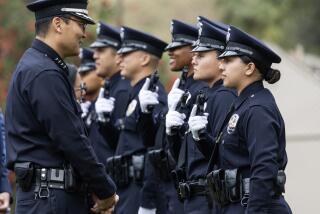LAPD’s use of protest dispersal orders soars, with few records justifying actions
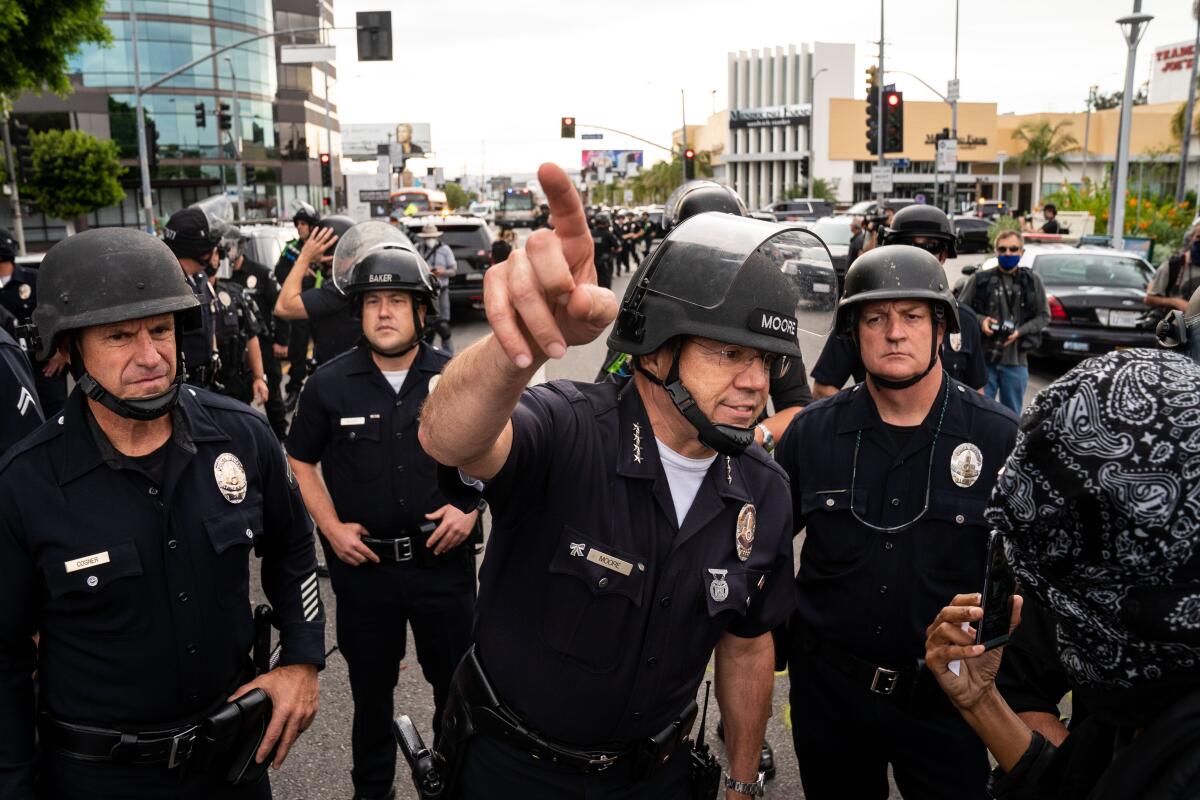
The Los Angeles Police Department has seen a dramatic increase in the use of dispersal orders as officials deal with rising numbers of intense street protests over police violence, homelessness, COVID-19 restrictions and other issues.
Such orders, in which police declare entire gatherings to be “unlawful,” have for decades led to thousands of arrests — of protesters but also of journalists — that were later rejected by prosecutors and exposed the city and its taxpayers to a mountain of lawsuits, including many that are pending.
But a Times investigation found that the LAPD has kept little record of such orders, its justifications for them or whether they were carried out in compliance with past court settlements or the department’s own policies. The LAPD had no centralized record or log of dispersal orders and no records outlining justifications for the majority of the orders.
LAPD officials say they are reviewing their record-keeping policies. But critics and legal scholars question why it has taken so long for careful documentation and oversight to become a priority, given the implications of such orders and their misuse in the past.
“We’ve been through this over and over again, and I don’t understand why they can’t get it right,” said Carol Sobel, an attorney who has repeatedly sued the city over dispersal orders, helped win past settlements mandating reforms and now represents Black Lives Matter Los Angeles in a lawsuit over last year’s events.
“It isn’t not knowing what they’re doing,” Sobel said. “It’s not caring.”
For the LAPD, it will be another period of forced change brought on by investigations and several lawsuits after the summer protests.
The Times filed a public records request in April asking the LAPD for a list of all dispersal orders issued since 2016 and any incident reports or other documentation capturing synopses or justifications for the orders.
The department produced documents listing dispersal orders issued in each of the four regional bureaus. The lists showed a total of two dispersal orders issued per year from 2016 through 2019, 17 in 2020 and three in the first half of 2021. The lists were incomplete, failing to note orders publicly announced or witnessed by Times staff.
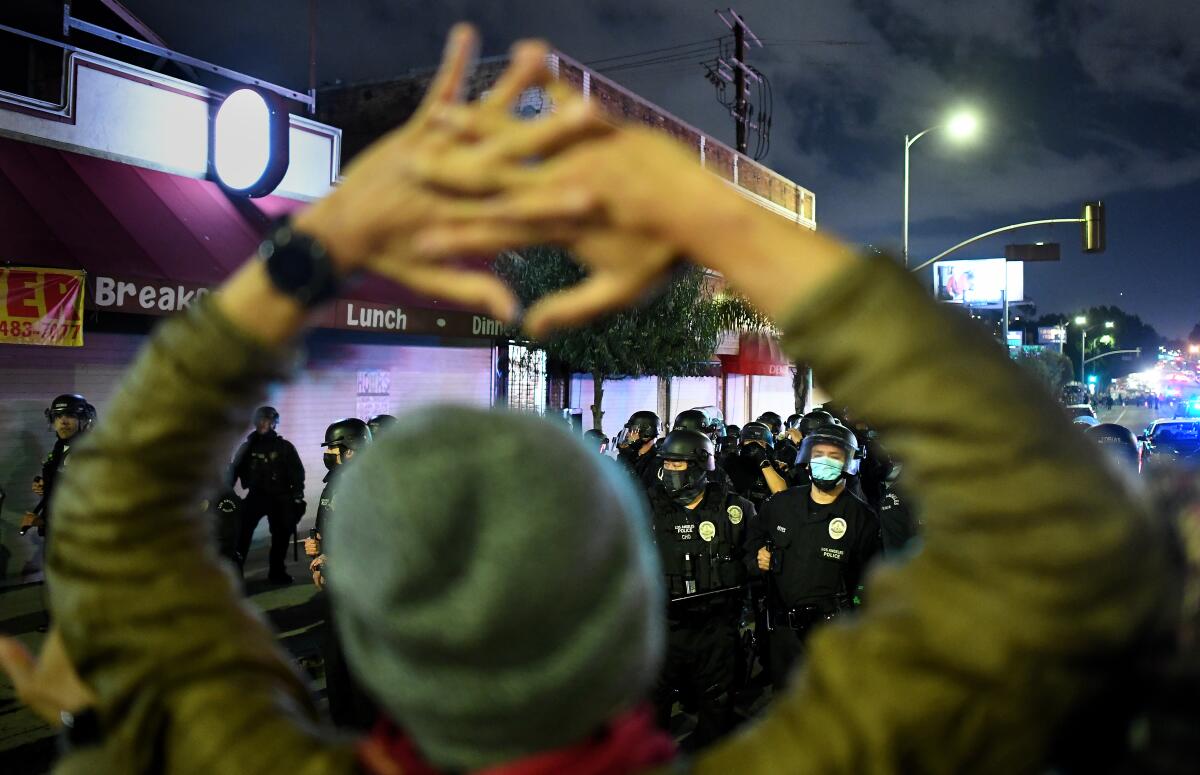
Some major events — like the mass demonstrations in the spring and summer of 2020 after George Floyd’s murder and protests in March in Echo Park — have led to broader reviews that considered the use and execution of dispersal orders. The department said it learned lessons from the Floyd protests, and its report on Echo Park detailed the use of dispersal orders in more detail.
However, no such reviews have occurred for smaller protests.
The lack of records has left LAPD officials exposed to withering questions in court cases over injuries officers caused to demonstrators, and struggling to back up their claims that the demonstrators had ignored dispersal orders before being wounded.
“There is a disconnect between the LAPD’s claim that they diligently give out these dispersal orders and document them, and the actual documented evidence,” said Pedram Esfandiary, an attorney who represents C.J. Montano, a protester who is suing the city after being shot in the head with a police projectile in May 2020 in the Fairfax district.
In a deposition last month in federal court, Esfandiary grilled Los Angeles Police Det. Thomas Brown about the LAPD’s use of dispersal orders at the Fairfax protest. Brown had led an internal investigation into the shooting and claimed in it that Montano had refused to comply with a dispersal order before he was shot.
“What dispersal order are you referring to?” Esfandiary asked the detective.
“Well, the dispersal orders that were given that day,” Brown said, “and the officers on the line yelling, ‘Leave the area.’”
As Esfandiary pushed Brown for details, it became clear that the detective had no evidence that a dispersal order had been given in the location where Montano was shot, and no evidence that Montano or other protesters had heard previous orders given elsewhere when they were shot at by an advancing skirmish line of officers.
Two more reviews have found glaring problems with the Los Angeles Police Department’s handling of last summer’s mass protests against police brutality.
In another deposition in the same case, Capt. Shannon Paulson — the initial incident commander in Fairfax — told Esfandiary that she knew of only one dispersal order that day, given in a different location from where Montano was shot.
“Do you know the specifics of that dispersal order in terms of the geographical bounds and how it was broadcast?” Esfandiary asked her.
“No,” Paulson said. “I don’t.”
LAPD policy calls for the date and time of such orders to be recorded, along with the names of the commanders who issued them, but has long been silent on whether more robust documentation should be kept, according to one of the broader reviews of the Floyd protests.
The department is in the process of revising its policies with the city attorney’s office to ensure better documentation, including by having officers record videos of their locations and the actions of crowds and storing the videos for future reference. Those strategies and others are part of a broader protest reform package that was discussed Tuesday before the Police Commission.
The plan calls out the lack of documentation from past events and acknowledges that this has hampered efforts to hold officers accountable.
“Because videographers were not trained, they did not capture details such as the commander’s intent, briefings, crowd size, crowd demeanor, actions taken by officers, uses of force, dispersal orders, arrests and/or additional evidence, and therefore, these details were not documented,” the plan says. “As a result, it is more difficult for the Department to assess the actions of its employees.”
An LAPD spokesman, asked about the documentation of dispersal orders, said the department was assessing “whether what we currently do is adequate” and that “revisions of policy or protocols do not occur overnight and require thoughtful analysis and consideration.”
Critics of the department said that response disregards the fact that the department has been reprimanded for its misuse of dispersal orders for decades.
Protesters, civil rights organizations and other observers of law enforcement have alleged that the LAPD is biased in how it uses such orders, and against whom. They say officers communicate dispersal orders poorly, ignore rules for when and how the orders can be issued, fail to give demonstrators adequate time to leave areas that are deemed off-limits and even box protesters into those areas before arresting them for being there.
More than 20 years ago, the LAPD was slammed for its use of a dispersal order at the 2000 Democratic National Convention, when it gave some 8,000 people 15 minutes to leave the area, then moved in with projectiles. The city was sued on multiple fronts, including by people who alleged they were given inadequate time to disperse. The city wound up paying millions of dollars to settle the cases and agreed to change the LAPD’s crowd-control policies to limit the use of projectiles.
The city vowed additional reforms after storming through a 2007 protest in MacArthur Park, beating protesters and journalists with batons and shooting them with projectiles. That case led to more than $30 million in payouts and a court order mandating tactical reforms — including a ban on the use of projectiles on people trying to leave a scene after a dispersal order has been given and new rules for how crowds must be informed of a dispersal order before it is enforced.
In another settlement, over the LAPD’s 2011 closure of an Occupy L.A. camp, the city agreed to stop “kettling” protesters — surrounding them without providing an exit path — when enforcing a dispersal order.
And the day after Floyd was killed on May 25, 2020, in Minneapolis, L.A. agreed to pay $750,000 to settle a class-action lawsuit brought by protesters who alleged they’d been unlawfully arrested, without a proper dispersal order, during 2014 protests over the police killing of Michael Brown in Ferguson, Mo. Again, the city agreed not to kettle protesters and to ensure that they are given a formal dispersal order and the opportunity to leave before being arrested.
Now, Sobel — who was involved in the past cases — is suing the city once more, this time on behalf of Black Lives Matter L.A., and alleging many of the same failings related to dispersal orders.
In the process, Sobel said the LAPD has produced few videos showing what the department argues were official dispersal orders during the events, despite the fact that police used such orders to make thousands of arrests in many locations in May and June 2020.
All of the documented orders were “grossly inadequate” to justify the LAPD’s actions clearing and arresting people, based on the reforms of the past and the LAPD’s own policies, Sobel alleged, and instead showed that the department was using the orders “to shut down protected speech.”
California law says gatherings can be declared unlawful when “two or more persons assemble together to do an unlawful act, or do a lawful act in a violent, boisterous, or tumultuous manner,” and courts have interpreted “boisterous” and “tumultuous” to mean conduct that poses a “clear and present danger of imminent violence,” according to LAPD policy and state records.
California’s guidelines on crowd management say that dispersal orders must be used only when the above criteria have been met and that police must convey to demonstrators the potential consequences of remaining in a location before moving in to disperse them. The guidelines say officers must give protesters sufficient time to leave after an order is given and must provide a clear path out of the area.
The LAPD’s policy states that officers must ensure that such orders are “given in a manner reasonably believed to be heard and understood by the intended audience” and must provide “a warning that force may be used which could result in serious injury.”
The policy states that “multiple announcements from various locations may be required” and that orders “should be delivered in English and in other languages that are appropriate for the audience.”
Ashutosh Bhagwat, a U.C. Davis law professor and constitutional scholar, said police have to be able to step in when large crowds grow violent and start causing property damage, as was the case last year in the Fairfax district.
However, they should also realize that dispersal orders are “in deep conflict with the 1st Amendment” if misused.
“The right to disperse an assembly only begins once things start to get out of hand, and by out of hand, I mean violent,” Bhagwat said. “The fact that an assembly is disorderly is not a sufficient reason to disperse it.”
Sobel said it has never been the contention of protesters that the LAPD should not be able to clear a crowd; however, the officers should have to follow an established set of rules when they do. Instead, Sobel said, the department has issued orders haphazardly and allowed its officers to brutally enforce them, with no clear documentation of their actions.
“I’m just stunned,” Sobel said, “that 20 years later, we’re still in the same position.”
More to Read
Sign up for Essential California
The most important California stories and recommendations in your inbox every morning.
You may occasionally receive promotional content from the Los Angeles Times.
